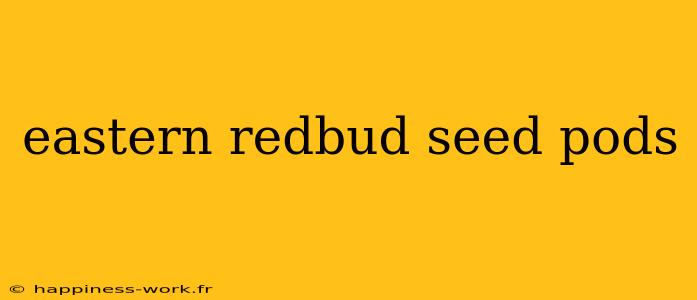The Eastern Redbud (Cercis canadensis) is a beloved tree native to eastern North America, renowned for its stunning spring blooms and heart-shaped leaves. However, one fascinating aspect of this tree often goes unnoticed: its seed pods. In this article, we’ll delve into the characteristics of Eastern Redbud seed pods, their lifecycle, and their importance in nature, while also answering some common questions surrounding this intriguing feature.
What are Eastern Redbud Seed Pods?
Eastern Redbud trees produce seed pods that are distinctively flat and elongated. These pods can be green during the summer months and mature to a dark brown or reddish-brown color in the fall. Each pod can contain several seeds, which are dispersed in various ways, contributing to the tree's propagation.
Key Characteristics of the Seed Pods
- Shape and Size: The seed pods are typically 2 to 4 inches long and ¼ inch wide, resembling flat pea pods.
- Color: Initially green, the pods darken as they mature, providing a contrasting visual against the autumn foliage.
- Texture: The pods have a smooth exterior that becomes fibrous as they dry out.
Lifecycle of the Eastern Redbud Seed Pods
- Pollination: The lifecycle begins in spring when the tree blooms with pink to purple flowers that attract pollinators such as bees.
- Pod Formation: Once pollinated, the flowers give way to seed pods, which develop throughout the summer.
- Maturation: By late summer to fall, the pods mature, turning brown and eventually splitting open to release seeds.
- Seed Dispersal: The seeds can be dispersed by wind, animals, or water, allowing the tree to propagate across its native range.
Frequently Asked Questions
How do you propagate Eastern Redbud from seed pods?
To propagate Eastern Redbud trees from seed pods, you can follow these steps:
- Collect Seed Pods: Wait until the pods turn brown and dry. Collect them from the tree or the ground.
- Extract Seeds: Open the pods to retrieve the seeds. They are small and round.
- Stratification: Since Eastern Redbud seeds benefit from cold stratification, place them in a damp paper towel, seal in a plastic bag, and refrigerate for about 30 days.
- Planting: After stratification, plant the seeds in a well-drained potting mix. Water them lightly and keep them in a warm, sunny location.
This process mimics natural conditions that help break seed dormancy, increasing the chances of successful germination.
Are Eastern Redbud seed pods edible?
While the young seed pods of the Eastern Redbud can be consumed when they are tender and green, it's essential to prepare them correctly. They can be boiled or sautéed, and some people enjoy them in salads or stir-fries. However, the mature seeds and pods are generally considered less palatable and may be tough or fibrous.
What wildlife benefits from Eastern Redbud seed pods?
The seed pods of the Eastern Redbud play a vital role in the ecosystem. Various birds, including squirrels, deer, and other wildlife, rely on the seeds as a food source during winter months when other resources may be scarce. This interaction emphasizes the importance of the Eastern Redbud not only as an ornamental plant but as a contributor to wildlife habitats.
Additional Insights
Landscaping and Aesthetic Value
In landscaping, Eastern Redbuds are prized for their early spring blooms and vibrant fall colors. Their unique seed pods, although sometimes seen as a nuisance due to litter, can add an interesting textural element to gardens and landscapes. Moreover, the branches, which sometimes twist and turn, create a striking silhouette against the sky.
Environmental Importance
In addition to providing food for wildlife, Eastern Redbud trees improve air quality and contribute to biodiversity. They are an excellent choice for urban environments due to their relatively small size, making them suitable for smaller yards or streetscapes. When planting Eastern Redbuds, consider their placement to maximize both aesthetic and ecological benefits.
Conclusion
The Eastern Redbud's seed pods, while often overlooked, are a fascinating aspect of this remarkable tree. From their distinctive characteristics and propagation methods to their role in wildlife sustenance, these pods illustrate nature's interconnectedness. By understanding and appreciating the complete lifecycle of the Eastern Redbud, we can foster a greater respect for our natural environment.
If you’re looking to incorporate this beautiful tree into your garden or landscape, remember to consider its ecological contributions along with its aesthetic appeal.
References: Information sourced and adapted from WikiHow articles related to seed propagation and plant care. Thank you to the original authors for their valuable insights!
